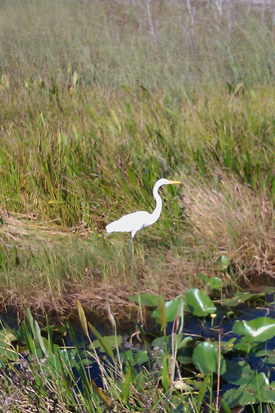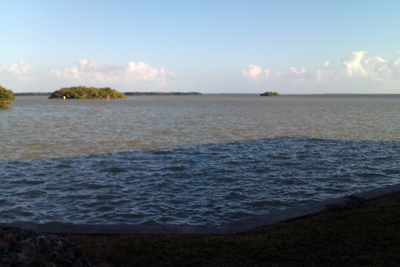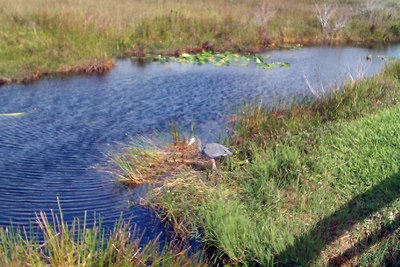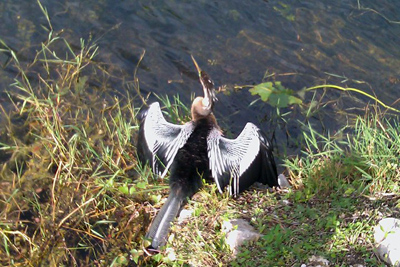
Hiking presents best Everglades landscapes
FLORIDA CITY, Fla. — The waterways known as the Everglades make up most of South Florida. Throughout the 1850s to the 1890s, there was an effort to drain the Everglades and plant sugarcane to help boost Florida’s economy.
Since both public and private sector thinking about the region’s environment has evolved during much of the 20th century from destruction to conservation and preservation, the Everglades National Park was created and has helped preserve what is left. Unfortunately this is less than 50 percent of what the Everglades was originally.
The Everglades is home to many different species and have some of the most beautiful landscapes in South Florida. One way to truly appreciate all the Everglades has to offer is to go on some of the walking and hiking trails that take visitors through the varying parts and to watch many species that call the Everglades home.
| Click on the video at the left to see a slide show about hiking and walking trails in the south portion of Everglades National Park prepared by writer Sasha Blaney. |
Once entering the park, visitors should make a quick stop at the Ernest F. Coe Visitor Center. The park ranger (or, at times, a staff volunteer) at the information desk will be very helpful and will distribute park maps. Each map has a key and helps point out locations of the various trails.
Birdwatching is a favorite activity while hiking the trails. Everglades National Park Public Information Officer Linda Friar said that bird life in the Everglades tends to move North in the park or South toward the Caribbean. Alligators and crocodiles have different courses as the seasons change.
“During the summer, the water level in the Everglades is higher so alligators move all over the park. However, from November to June, the park dries down so alligators and crocodiles move towards the water. This tends to be near the visitor walking trails,” Friar explained.
The trail that takes visitors to where all of these species come together in winter is in the Royal Palm section and is known as Anhinga Trail. The Anhinga Trail is partly asphalt and partly an above ground wooden trail that resembles a beach boardwalk. The boardwalk stretches out over the Everglades so people can wander deeper into the area and over water.
| At right, an egret with its bright white feathers, is commonly seen around Anhinga Trail in Everglades National Park (Photos by Sasha Blaney). Below, the view from the Visitor Center at Flamingo, near the Guy Bradley Trail. |  |
While walking this trail, alligators tend to pass under on their way to drier ground.
“I was hoping to see alligators while visiting, but I had no idea I was going to see seven of them laying in the sun next to each other,” one visitor commented. “The biggest alligator had to be at least six feet long!”
The day that my friend and I chose to go hiking was rather warm and groups of alligators gathered on dry ground to sunbathe together. Birds spread their wings after taking a dip in the water and many grasshoppers baked in the sun while trying to blend in with the tall grass.
 The Anhinga Trail is not that long and can be done in about 30 minutes.
The Anhinga Trail is not that long and can be done in about 30 minutes.
From the south entrance of the park at the Ernest F. Coe Visitor Center to the end of the road at the Flamingo Visitor Center about 38 miles later, there are six different hiking trails that can be taken.
When gathering information about each hike, park rangers will tell you which ones are ideal for each time of year based on the amount of mosquitoes that inhabit and breed in the Everglades.
“June to November is when mosquitoes are at their highest levels in the park and from August to September there at their worst. Between January to May is when the park offers the most activities,” Friar stated.
Once reaching the southernmost point of the park, which is about an hour drive south of Ernest F. Coe Visitor Center, visitors should stop in at the Flamingo Visitor Center and talk to a park ranger.
The ranger inside the Flamingo Center is well educated on the Flamingo trails and will help visitors decide which one is worth hiking. There aren’t that many to choose from and the choices narrow even more when considering the amount of mosquitoes at each site.
When I went, the ranger told my companion and I that the mosquito levels were rather high and the only trail she would recommend was the Guy Bradley Trail, which leads hikers to the camping ground.
| At right, a bird waits for the right moment to nab a fish in the water near Anhinga Trail. Below, an anhinga dries its feathers after diving into the water to search for fish. |  |
Entering the Guy Bradley Trail from the parking lot there is not much to see at first. As hikers come around the curve the trees open up and display a beautiful serene view of the ocean on one side and marsh-like land on the other.
The mosquitoes were not unbearable, but did not help make the trail any more enjoyable.
“Next time I do a hike through here, I plan on wearing long sleeves and mosquito repellant,” my companion, 22-year-old Brendan McNaboe noted.
That is a note I mentally took down as well.
“Hiking, kayaking and canoeing are all available at the park it all depends on the visitors own ability,” mentioned Friar. “We even have a wet walk through the Everglades which is led by a ranger and takes place from January to May.”
If a whole day can be devoted to venturing into Everglades National Park, making a visit to Flamingo worthwhile. The park has so many different aspects to it and both the northern and southern parts have different views worth seeing. Hiking is one of the easiest ways for visitors to see what the park has to offer, whether it’s beautiful views or interesting species.
 If You Go
If You Go
Address: 40001 State Road 9336, Homestead, Fla. 33034-6733.
Wear comfortable shoes, bring bug repellant if you plan on going south.
It is an hour drive if you are coming from Miami and another hour if you would like to cover the whole park. There is a main road that runs from the entrance of the park down to the Flamingo Visitor Center.
To become familiar with the whole park, first enter the Ernest F. Coe Visitor Center that will be on your right. If you go inside, there is a volunteer or a ranger who will give you further directions into the park and a map.
The entrance fee to enter the park is $10 per car, but hiking throughout the park is free.
There are concession stands and bathrooms on site at all visitor centers and at the Anhinga Trail.

Comments are Closed